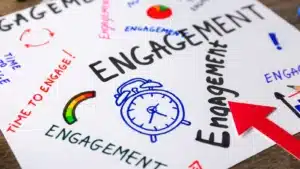
Meeting Icebreaker Activities That Actually Work (No Eye Rolls)
Icebreakers are essential tools for fostering engagement and building rapport among team members, especially in meetings where participants may not know each other well. They serve to create a relaxed atmosphere, encouraging open communication and collaboration. When implemented effectively, icebreakers can transform a mundane meeting into an interactive experience that energizes participants and enhances productivity.
The Importance of Icebreakers in Meetings
In a world where virtual meetings have become the norm, the challenge of keeping everyone engaged is more significant than ever. Many presenters, like Jamie, a sales manager at a tech company, struggle to capture attention and encourage participation during presentations. By incorporating effective icebreaker activities, the likelihood of achieving a dynamic and productive meeting increases significantly.
Moreover, icebreakers can help to break down hierarchical barriers that often exist in corporate settings. When team members are encouraged to share personal anecdotes or participate in light-hearted activities, it humanizes them and fosters a sense of equality. This is particularly beneficial in diverse teams where cultural differences may impact communication styles. For instance, a simple game that prompts participants to share their favorite hobbies can reveal common interests, paving the way for stronger interpersonal connections and a more cohesive team dynamic.
Additionally, the choice of an icebreaker can be tailored to suit the specific goals of the meeting. For example, if the objective is to brainstorm new ideas, an icebreaker that encourages creative thinking can set the right tone. Activities such as “Two Truths and a Lie” or “The Marshmallow Challenge” not only serve as fun introductions but also stimulate innovative thinking and problem-solving skills. By aligning the icebreaker with the meeting’s purpose, facilitators can enhance the overall effectiveness of the session, ensuring that participants are not only engaged but also mentally prepared to contribute meaningfully to the discussions ahead.
Types of Icebreaker Activities
1. Fun and Interactive Questions
One of the simplest yet most effective icebreaker activities involves asking fun and interactive questions. These questions can range from light-hearted topics, such as “If you could have dinner with any historical figure, who would it be?” to more thought-provoking queries like “What is one skill you wish you could master?”
These questions not only serve to lighten the mood but also allow participants to share personal insights, fostering a sense of connection. In virtual settings, tools like SMS-based engagement platforms can facilitate this process by allowing participants to respond anonymously, encouraging even the shyest individuals to share their thoughts. Additionally, incorporating themed questions based on current events or seasonal topics can further enhance engagement. For instance, during the holiday season, asking about favorite traditions or holiday foods can spark lively conversations and shared experiences.
2. Quick Team Challenges
Engaging participants in quick team challenges can create a sense of camaraderie and teamwork. Activities such as a two-minute trivia quiz or a rapid-fire word association game can energize the group and stimulate interaction. These challenges can be easily conducted through chat functions in virtual meetings, allowing for seamless participation.
Moreover, the use of platforms that offer real-time analytics can help presenters gauge engagement levels during these activities. By tracking participation metrics, presenters can tailor future icebreakers to suit the preferences of their audience, ensuring that every meeting is more engaging than the last. Furthermore, introducing friendly competition through team-based challenges can elevate the excitement. For example, splitting participants into small groups to solve a puzzle or complete a scavenger hunt can not only break the ice but also promote collaboration and strategic thinking among team members.
3. Personal Sharing Moments
Encouraging participants to share personal stories or experiences can deepen connections among team members. This could be as simple as inviting each person to share their favorite vacation destination or a memorable moment from their career. Such sharing moments can lead to laughter, empathy, and a greater understanding of one another.
Incorporating these personal sharing activities into meetings not only breaks the ice but also sets a positive tone for the rest of the session. It creates an environment where participants feel valued and comfortable expressing themselves, ultimately leading to more productive discussions. To enhance this experience, facilitators can introduce prompts that encourage vulnerability, such as asking participants to share a challenge they overcame or a lesson learned from a failure. These deeper conversations can foster trust and authenticity within the group, laying the groundwork for more meaningful interactions in future collaborations.
Implementing Icebreakers in Virtual Meetings
4. Use Technology to Your Advantage
In virtual meetings, leveraging technology can enhance the effectiveness of icebreakers. For instance, using SMS-based platforms allows participants to engage without the need for additional apps or downloads. This frictionless experience encourages more people to participate, as seen with PresEngage, which transforms one-way presentations into dynamic two-way conversations.
By incorporating features like real-time Q&A and anonymous participation, presenters can ensure that every voice is heard, and every question is addressed. This not only enhances engagement but also captures valuable insights that can be used for follow-ups and future presentations. Furthermore, integrating fun elements such as polls or quizzes can add an interactive layer to the icebreaker process, making it more enjoyable and memorable for participants. For example, a quick poll about favorite hobbies can spark lively discussions and help team members discover shared interests, fostering a sense of camaraderie.
5. Create a Dedicated Icebreaker Slide
Having a dedicated icebreaker slide at the beginning of a presentation can serve as a visual cue for participants. This slide can display the icebreaker question or activity, making it easy for everyone to follow along. It also sets the expectation that participation is encouraged from the outset.
Additionally, including a QR code on the slide can facilitate instant connection to the presentation materials, allowing participants to engage with the content seamlessly. This method not only enhances engagement but also ensures that participants have easy access to the information they need throughout the meeting. To further enrich the experience, consider incorporating visuals or animations that relate to the icebreaker theme, which can help to capture attention and create a more inviting atmosphere. Engaging graphics can stimulate conversation and make participants feel more at ease, paving the way for a productive meeting.
6. Follow Up on Engagement
After the icebreaker activities, it’s crucial to follow up on the engagement generated during the meeting. This can be done through personalized follow-up messages that reference the icebreaker discussions. By acknowledging participants’ contributions, presenters can reinforce the sense of community and encourage ongoing dialogue.
Utilizing automated follow-up tools can streamline this process, ensuring that no valuable insights or leads slip through the cracks. For instance, platforms like PresEngage automate lead capture and follow-up, allowing presenters to focus on delivering their message while still nurturing connections made during the meeting. Additionally, consider creating a shared document or a group chat where participants can continue the conversation post-meeting. This ongoing interaction not only solidifies relationships but can also lead to collaborative opportunities, as team members feel more connected and motivated to engage with one another beyond the confines of the virtual meeting space.
Creative Icebreaker Ideas for Different Settings
7. For Corporate Meetings
In corporate settings, icebreakers can be tailored to align with company culture and objectives. For example, a “Show and Tell” session where team members share a favorite work-related item can foster a sense of belonging and teamwork. This activity not only breaks the ice but also allows participants to learn more about each other’s roles and contributions.
Another engaging option is a “Two Truths and a Lie” game, where each participant shares two true statements and one false statement about themselves. This fun activity encourages team members to interact and guess each other’s lies, promoting a light-hearted atmosphere while building rapport.
8. For Educational Settings
In educational environments, icebreakers can help create a collaborative learning atmosphere. Activities like “Speed Networking,” where students rotate and introduce themselves to various peers, can encourage interaction and help build a sense of community. This method allows students to connect with multiple classmates in a short amount of time, fostering collaboration and teamwork.
Another effective icebreaker is the “Common Ground” activity, where participants identify shared interests or experiences. This can be particularly beneficial in diverse classrooms, as it highlights commonalities among students and encourages inclusivity.
9. For Virtual Events and Webinars
For virtual events, creative icebreakers can help set the tone for an engaging experience. Consider incorporating a virtual scavenger hunt, where participants are challenged to find and show specific items from their homes. This interactive activity not only breaks the ice but also adds an element of fun and excitement to the virtual setting.
Additionally, utilizing polls or quizzes related to the event topic can engage participants right from the start. This method not only encourages interaction but also provides valuable insights into the audience’s knowledge and interests, allowing presenters to tailor their content accordingly.
Measuring the Success of Icebreakers
10. Gathering Feedback
To assess the effectiveness of icebreakers, gathering feedback from participants is crucial. This can be done through quick surveys or informal discussions after the meeting. Questions can range from how comfortable participants felt during the icebreaker to whether they felt more engaged in the meeting as a result.
By analyzing this feedback, presenters can identify which activities resonated most with their audience and adjust future icebreakers accordingly. This iterative approach ensures that every meeting continues to evolve and improve, ultimately leading to more successful outcomes.

11. Analyzing Engagement Metrics
Utilizing analytics tools can provide valuable insights into participant engagement during icebreaker activities. Metrics such as participation rates, response times, and interaction levels can help presenters gauge the effectiveness of their chosen icebreakers.
For instance, platforms that offer audience intelligence and analytics can track engagement metrics, allowing presenters to tailor future presentations based on data-driven insights. This approach ensures that icebreakers remain relevant and impactful, fostering a culture of continuous improvement.
12. Adjusting Based on Outcomes
Finally, it’s essential to adjust icebreaker strategies based on the outcomes of each meeting. If certain activities consistently lead to higher engagement and positive feedback, they should be incorporated more frequently. Conversely, if specific icebreakers fail to resonate, they can be modified or replaced with more effective alternatives.
This adaptive approach ensures that icebreakers remain fresh and engaging, keeping participants excited and eager to contribute in future meetings.
Turning Meetings Into Conversations That Count
Icebreakers are invaluable tools for enhancing engagement and fostering connections in meetings. By implementing fun and interactive activities, leveraging technology, and measuring success through feedback and analytics, presenters can create dynamic environments that encourage participation and collaboration.
Incorporating effective icebreakers not only transforms meetings into engaging experiences but also empowers presenters to connect with their audience on a deeper level. As seen with innovative platforms like PresEngage, the integration of AI-powered tools can further enhance audience engagement, ensuring that every meeting is not just a presentation, but a conversation that drives real results.
With the right strategies in place, meeting icebreakers can become a powerful asset in any presenter’s toolkit, leading to more productive discussions and successful outcomes.
Ready to Break the Ice with PresEngage?
Transform your meetings from routine to remarkable with PresEngage. Our AI-powered SMS Q&A platform is the game-changer you need to facilitate real-time interaction and engagement without the hassle of apps or technical hiccups. Whether you’re a presenter, educator, trainer, or business professional, PresEngage is designed to help you connect with your audience and ensure every question sparks a conversation. Elevate your audience engagement and turn every presentation into an opportunity for conversion. Start for FREE today and experience the power of seamless, interactive presentations with PresEngage.
You Finish. Your Presentation Doesn't.
Dazzle your audience with Real-Time Q&A powered by your AI Co-Presenter.(Patent Pending)
PresEngage™ makes you look brilliant by connecting with everyone, instantly.
No Credit Card Required. 100% Risk Free.
Frictionless Audience Experience GUARANTEED.






